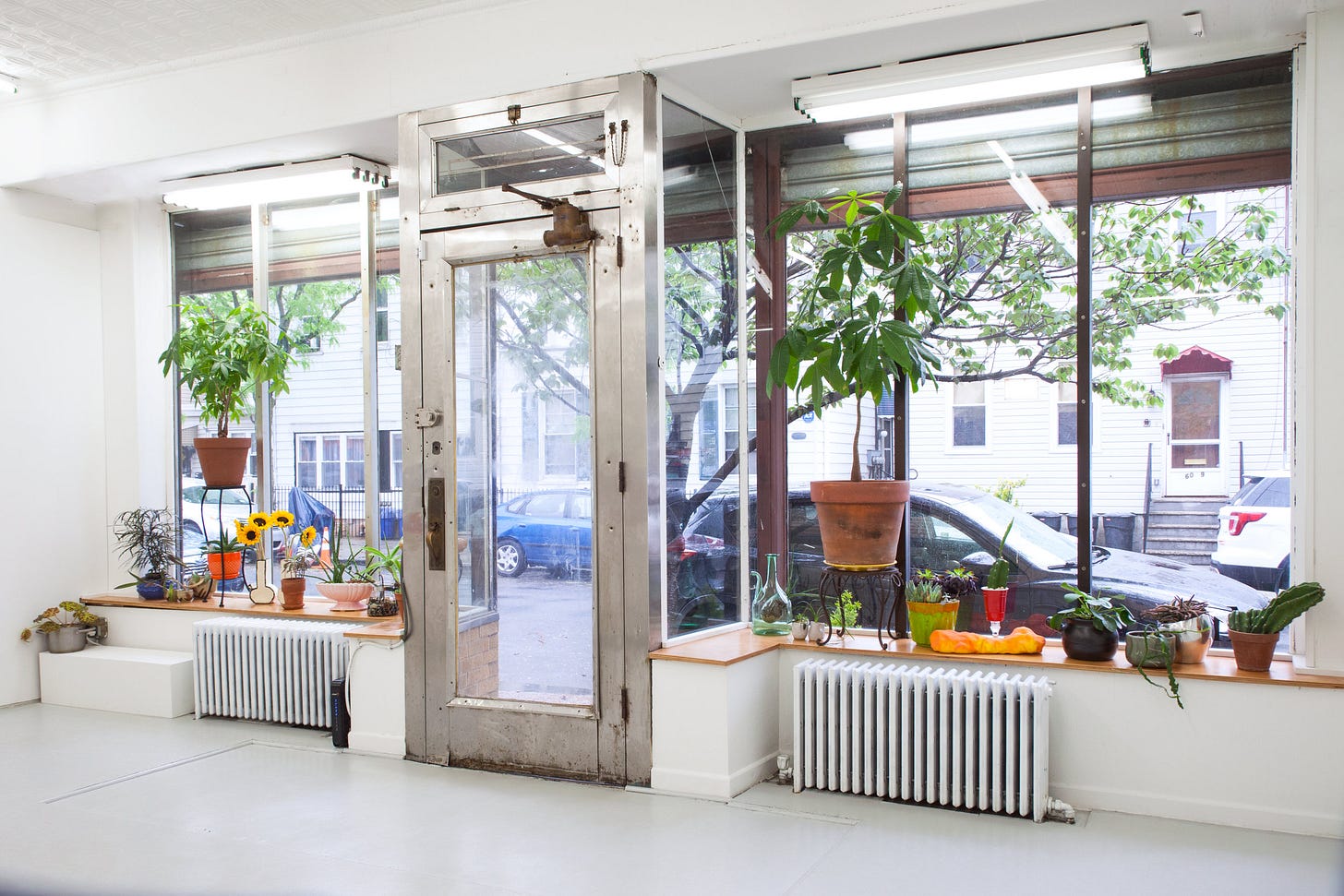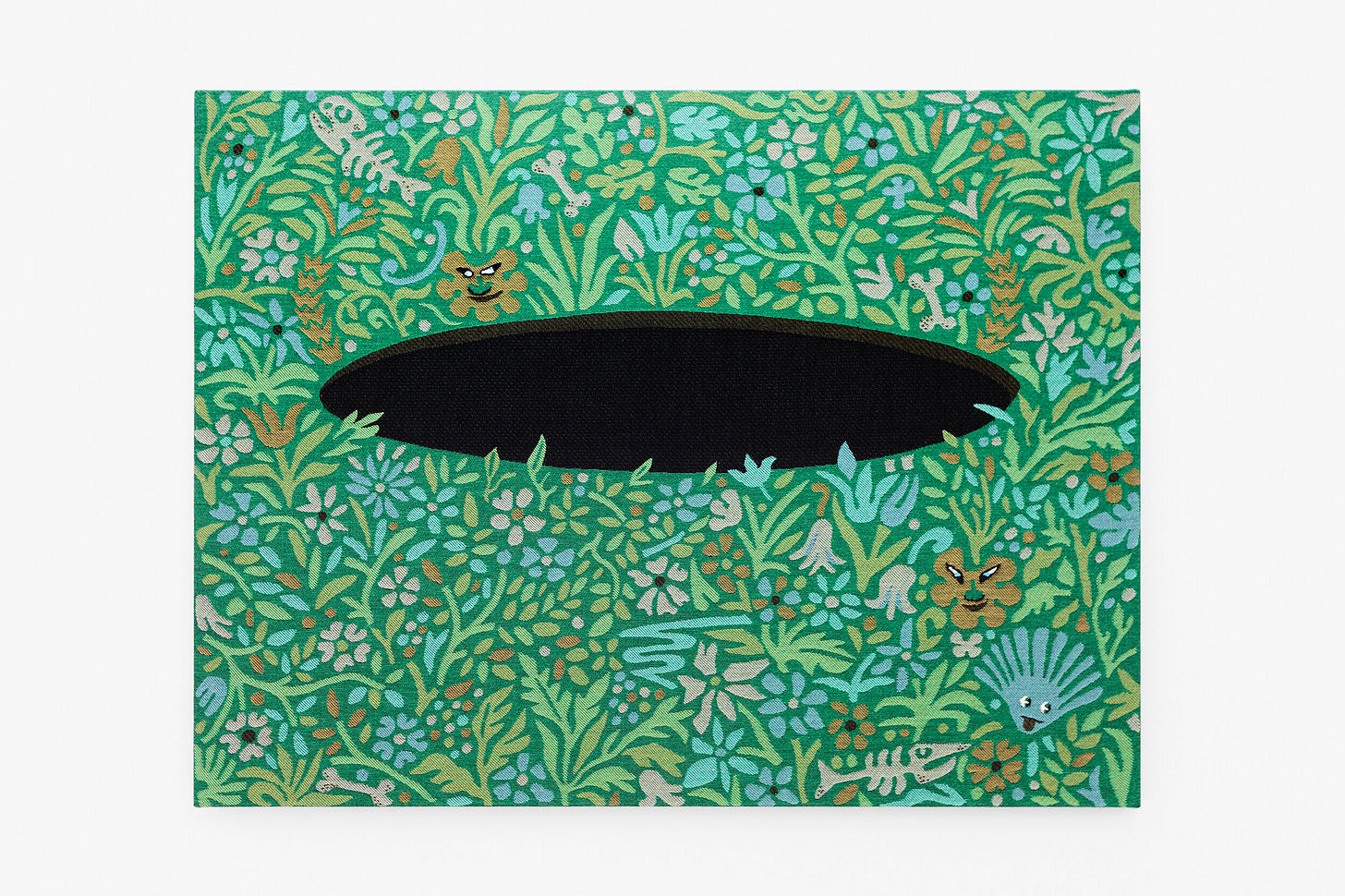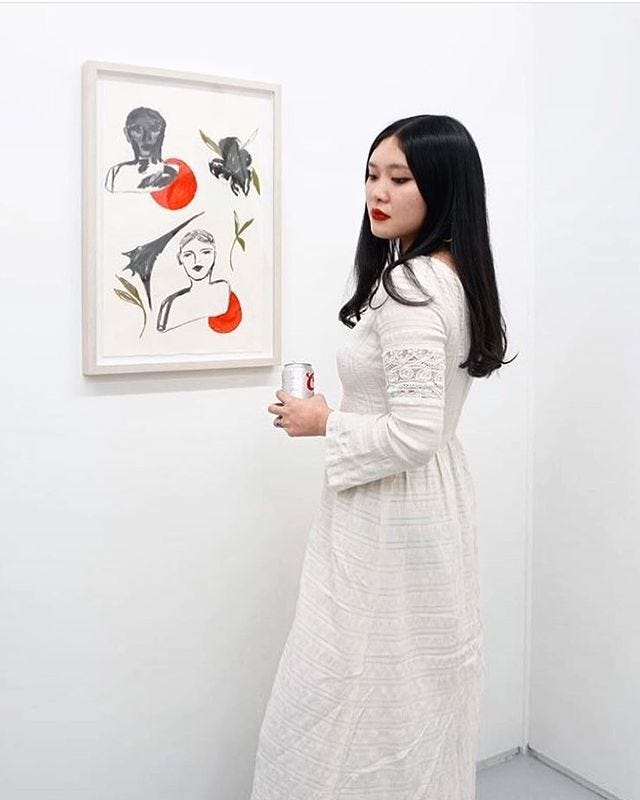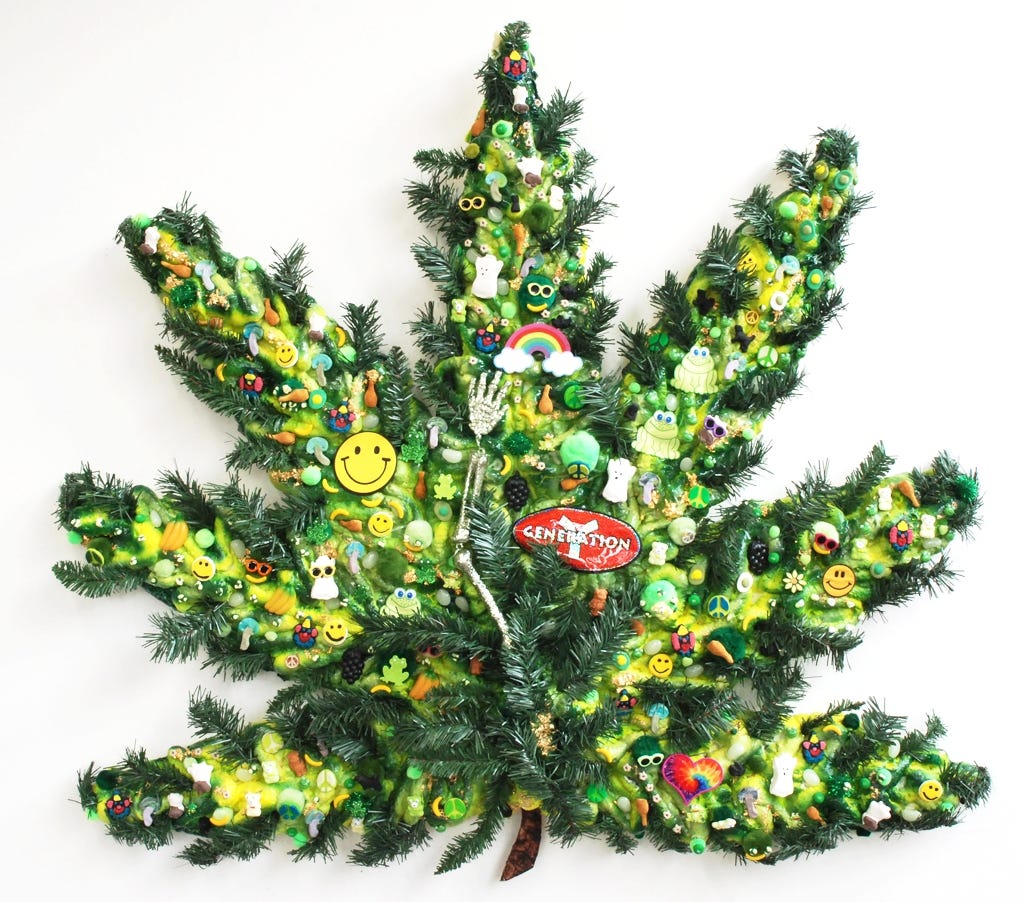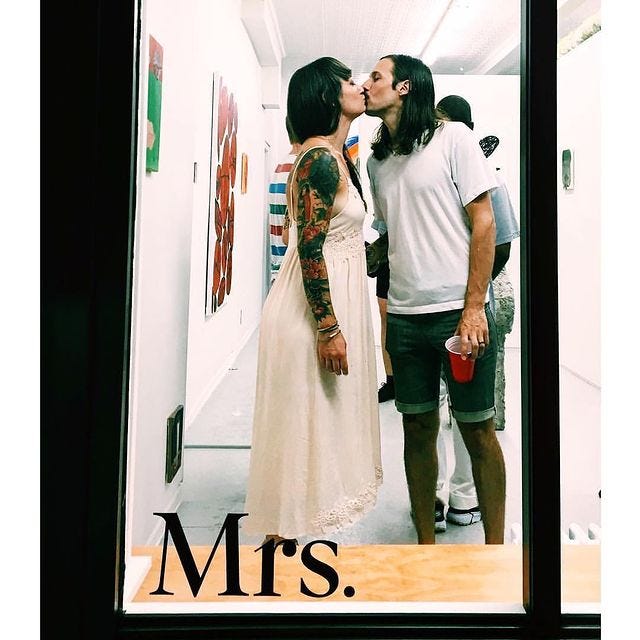Going DIY in the Art World (or Any World)
Mrs. gallery co-owners Sara Maria Salamone and Tyler Lafreniere on striking out and finding a community.
Co-owners Sara Maria Salamone and Tyler Lafreniere posing in front of the work of Omari Douglin.
Hi all, sorry it’s been a minute.
In November, my partner and I relocated (temporarily) to a cabin about half-an-hour outside of Hudson. It’s been a wild ride. Other than becoming bog influencers, there has been a lot of winterizing, learning where to buy milk and eggs, what a backup generator is, and just general “moving” going on.
With the events of this week bringing in an air of hopefulness, it felt like an ideal time to release our interview with Sara Maria Salamone and Tyler Lafreniere, the husband-and-wife team behind Maspeth’s Mrs. gallery (full disclosure, Tyler, a talented artist, created our Slow Ghost logo). A True DIY art space thriving in a city that has been absolutely pummeled by gentrification and now faces an uncertain future, Mrs. is “the little gallery that can”—and so much more.
Window installation by Courtney Childress in Dutch Masters, 2018.
The NYC art world, to be crass, runs on money and buzz. Lots of it. But what if you aren’t launching with an abundance of either? Such was the case for Sara Maria Salamone and Tyler Lafreniere, creators of Mrs. gallery in Maspeth, Queens. Opened in 2016 as a passion project for two artists also juggling the care of their young child, pursuing creative work, and simply trying to make a meaningful life structurally and financially possible—a struggle many New Yorkers can relate to—today Mrs. has been transformed into a true success, showing at NADA and Frieze, and with press in The New Yorker, Artforum, and The New York Times. But what does it take to go DIY in an era of instability? Both a lot and a few key elements.
Genesis Belanger, Cheap Cookie and a Tall Drink of Water, 2017. Courtesy Mrs.
What made you wanted to start a gallery?
SMS: To be honest, I had gotten to the point where I was tired of people telling me what to do (laughs). I’d worked in so many different realms of the art world, including art fairs, big galleries, little galleries, non-profits, and also as an artist myself—which was never very lucrative. At all. For anyone. But I had also been a director at a gallery on the Lower East Side. It was tough to get my ideas through, even though I was supposed to have a voice in programming. After I left, I took all of the ideas I had generated and began reaching out to other artists I knew and it happened organically.
Your gallery is in an unconventional space—an old-school, two-floor mixed residence/storefront far from any train line. How did you decide on Maspeth?
SMS: We both needed a space. When I left my job, I wanted to do some kind of exhibition space, and Tyler needed a studio. As we were renovating, I realized I was not going back to work for anybody else and that the “weekend project space” we had planned was turning into a full-on contemporary, commercial gallery for emerging art in the middle of Queens. So, there was a moment where we looked at each other and just went “we’re doing it!”
TL: I think the timeline of events played into it too. I’d been looking for a studio for ten months in Greenpoint, where we lived, and could only get a tiny back closet in somebody else’s studio. This was a moment when Sara had moved from a gallery director job to another gallery where she was hired with the expectation that she was going to have a lot of control over the programming. It quickly became apparent that this was not going to be the situation.
Sarah Palmer, Outs & Ins, 2019-2020. Courtesy of Mrs.
SMS: When I wrote my formal letter of resignation at my last job, I thought, “what am I working toward? What is the point of this?” It seemed the only way that I would be able to do what I thought I might be good at, and get a bigger chance at doing, was to do it ourselves. Finding a space with big storefront windows was an ideal situation.
TL: It felt like a sign. You’re asking these questions to the universe and trying to find them through traditional avenues, and working for someone else, and then up on Craigslist comes this space, and it’s perfect? Maybe you should listen to the universe.
Was it hard to get the initial roster of artists to take a chance on a new gallery?
SMS: We started out with an artist I had just shown on the Lower East Side. We had also been talking with different people within our careers, had been on so many studio visits, and were lucky enough to already know people interested in showing who had a pretty substantial studio practice. But it wasn’t hard to find people to say yes.
TL: I think the space plays into that a bit. And the seriousness, the commitment, that we both bring to the project. I’d like to think that it set us apart. At least it did during the time we were starting—that we were in a similar vein as other artist-run spaces but newer, not in Manhattan. I think that came through and made it an exciting opportunity to work with us.
SMS: When we were first starting, we did a couple of shows. Particularly Cake Hole, organized with Doppelganger Projects, with artists from all backgrounds. We had Will Cotton, who is more established, but also Aubrey Leventhal, Caroline Wells Chandler, Jennifer Coates. A mix of creators with history and depth to their work, alongside new, fresh talent. Then we did the “pot show,” Dutch Masters, where we had a breadth of artists, from Fred Tomaselli to Chris Bogia. Looking back, we’ve worked with most of these people throughout our careers or met them through colleagues. It’s been a nice transition to finding the roster that we now work with more independently. Which is great, but it took us four years to do it.
Oona Brangam-Snell, A hole, 2020, Jacquard Woven Cotton with Hand Embroidery.
When Mrs. opened—Sara, you were still bartending, and Tyler, you had just started a job at Adobe—did you both have to just “take a chance”?
SMS: It was and still is a lot of hard work, but I feel like we’re settling in a bit. But we grew so fast. The year we opened, we only had hours on Tues, Wednes, Thurs, and Sat because it fit my bartending schedule. Then Ryan Wilde, our friend, said, “I’ll intern on Fridays!” and gallery sit. Suddenly, we were open Tues-Sat. The third year, we were able to hire help, and now we have a nearly full-time gallery manager. It’s finally starting to feel like it’s a manageable ship to run.
TL: When we started, we didn’t call it a project space. We talked about it with each other almost as a way of pretending that’s what we’re doing, when really what we’re doing is “the other thing”—starting a “real” business.
SMS: I had left a job I felt very passionate about, where I’d known all of the artists—and it was heartbreaking to be the one to tell them the gallery was closing. I feel like everyone gets shit on the art world at some point in their lives. It doesn’t matter how hard you try not to get shit on. I think, after that, I was just “done.” And I didn’t realize I was done until we had white walls and were like, “alright. We’re doing this!” Ultimately, this was the right move. I don’t want to have to do this for somebody else. It’s great to be able to work for yourself.
Is the location ever an issue?
SMS: I was inspired by Kristin Dodge, who now runs September in Hudson and also had a space on the Lower East Side. I loved that she had the balls to say, “fuck it, I can do this from wherever I want.” There was a time when a person had to be in Chelsea, in Manhattan, but Hurricane Sandy totally decimated everything. I also began noticing galleries in LA, London, Berlin, on Instagram. I thought, “alright, I have a photography background, we can definitely do this well enough that we can do online exhibitions.” It was helpful to have that imagery because if we didn’t, I don’t think that people would have come. But it’s still a challenge—you can only get here by bus. It began to feel like more of a destination.
From Dutch Masters. Caroline Wells Chandler, Green Goddess, 2013.
Does it help that your partner co-runs the space?
TL: I think it helps! I’ve stepped back from the day-to-day stuff that I was more involved in early on. We were both working other jobs. I think it’s bad for people to always assume, “I can do this with no other source of income!” because usually, that’s not the case.
It’s also inspiring to those who work day jobs and want to do something more.
TL: Yeah! But early on, we were doing everything. Art handling. Shipping. Managing and manning the gallery, painting the walls, figuring out the programming, writing—and also trying to run a business. I think it was, and is, a huge advantage to us to be married and doing this together. We’re partners in all things. I won’t say it “gives us flexibility,” but if we need to do something for the gallery we can work together to figure out how to shift to accommodate because the rest of our lives are also intertwined.
SMS: To me it feels more secure than working with somebody that isn’t my partner. If I get mad at him, I can just get mad. I can express those emotions and call him a name if I need to. You cannot do that to your colleagues. And if you are doing that, DON’T DO THAT. We also work well together, which has been a huge benefit. If there’s something I’m unsure about and need to conference with him, he will have the right answer. Or the right questions. If there’s an artist that we’re unsure about and one person vetos—that’s the answer.
You manifested the perfect space. What’s your next vision?
SMS: We would love to have a larger space in Maspeth. In 6-10 years, a space in LA. I don’t know what fairs are going to look like in the future, but I’d like to do the smaller ones. We knew early on we wanted to do something different and the growth we’ve been lucky enough to have, in the short time we’ve been open, has owed to that being a driving goal from the get-go. How do we get there without just following the standard model of “start business, go into debt.” Which was just not something we felt comfortable doing. And it’s worked—so far?
Image courtesy of Tara Rice Photo.
Oona Brangam-Snell, Snowclones, January 16 - March 13, 2021 mrsgallery.com
Read on:
How retro ambient Japanese music got big on YouTube.
The Island of Happiness: Tales of Madame d’Aulnoy, artist Natalie Frank’s take on seventeenth-century French fairy tales.
Inside Turkmenistan's extravagant and empty tourist resorts.
Meet Seth Siegelaub, the Bronx-born curator who launched a global one-man operation and brought conceptual art to the mainstream.
See:
A photo-journey through Madrid’s snack bars. (Elephant)
The best Soviet sci-fi films. (Calvert)
The photographer who captured aging in real-time. (The New Yorker)
When Maripol shot Sade. (The Guardian)
28 illustrators to know now. (CreativeBoom)
Support:
For Freedoms, an artist-led organization amplifying creative civic engagement.
Nomadic traveling art museum Black Cube, which produces projects in spaces like abandoned bus terminals, gold mining towns and chapels.
Slow Factory’s One X One, the world’s first science x fashion incubator, and watch this doc by Christelle de Castro about the program's pilot year. Catch more Christelle in our 2017 interview with Agnes Varda.
Check out:
Daniel Johnston: Psychedelic Drawings at Electric Lady Studios, curated by Gary Panter, as part of the Outsider Art Fair. (Ongoing till February 8.)
An interactive introduction to printmaking with linoleum w/ Shoestring Press.
Have an upcoming project, story, or launch? HMU at slowghost@substack.com.
Want to support the work we’re doing? Become a paid member and make my day.
Slow Ghost is a newsletter covering the next wave in culture, brought to you by writer, producer, and Design & Tech Editor at Kickstarter Laura Feinstein.





